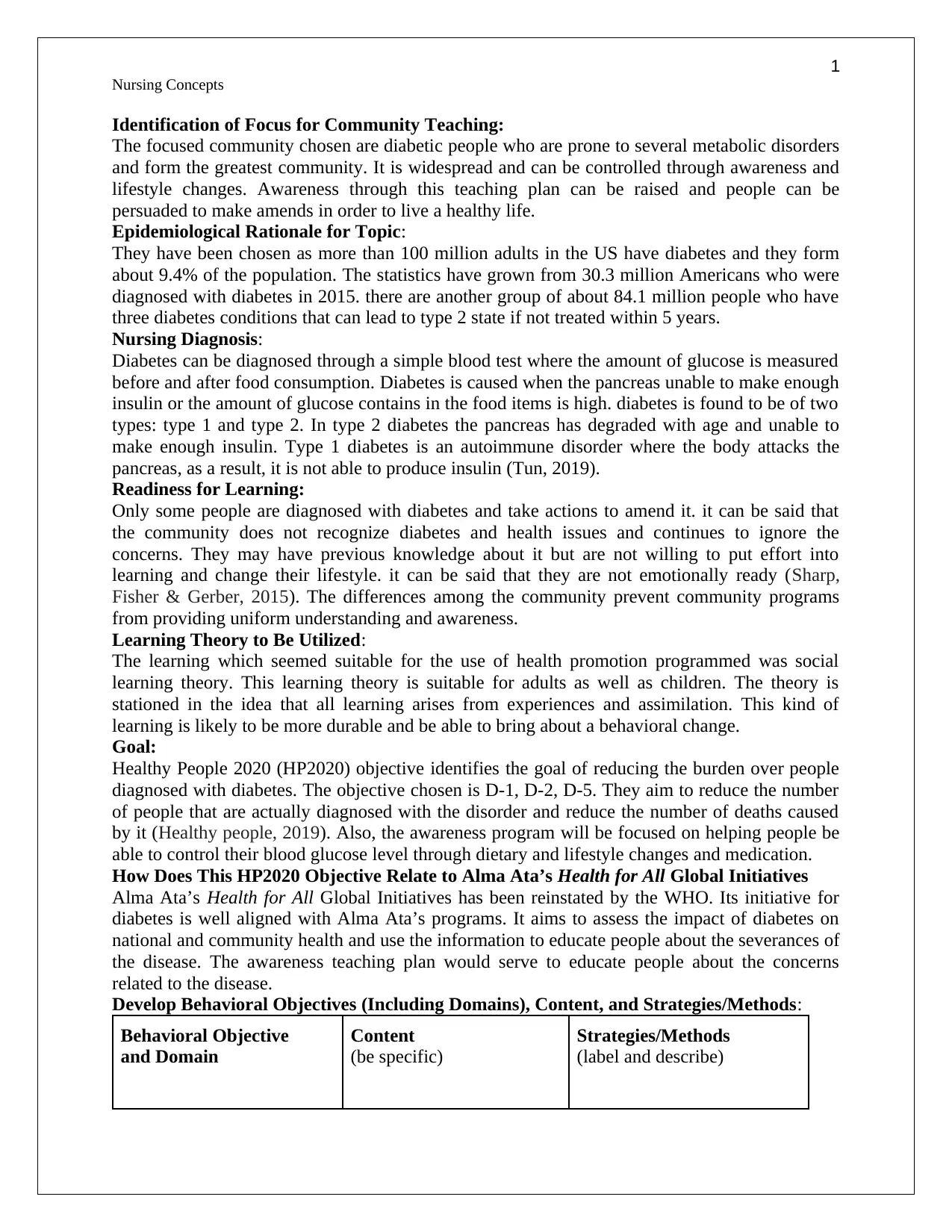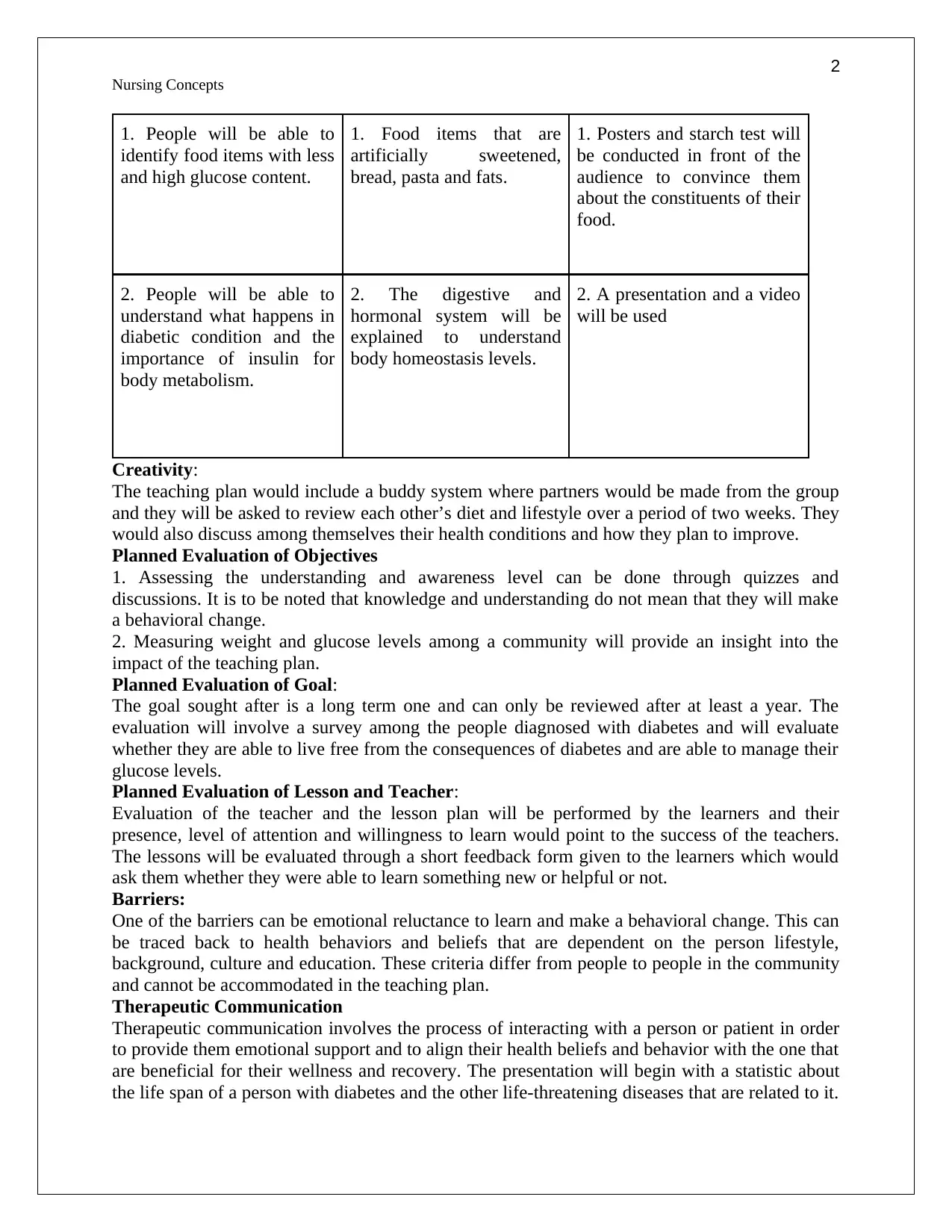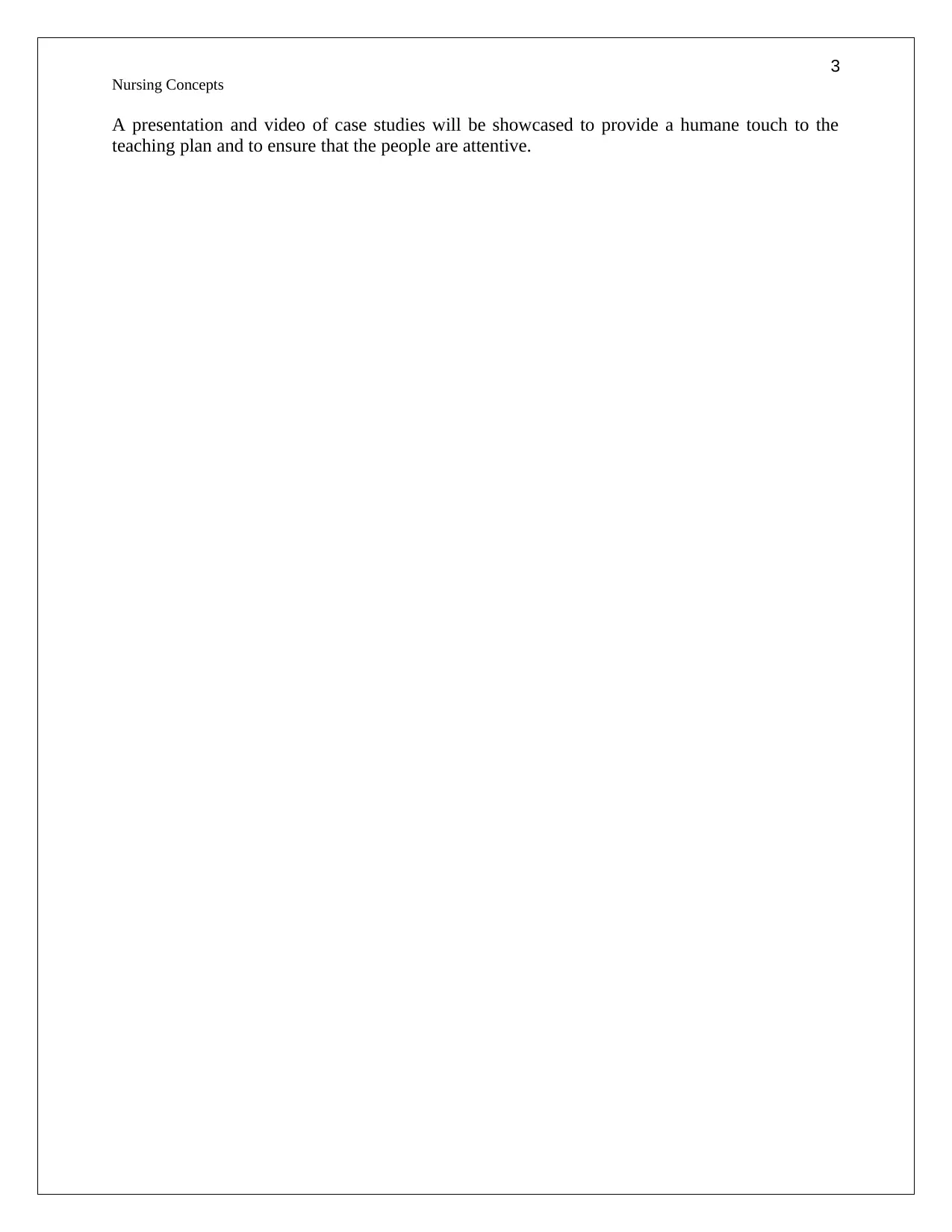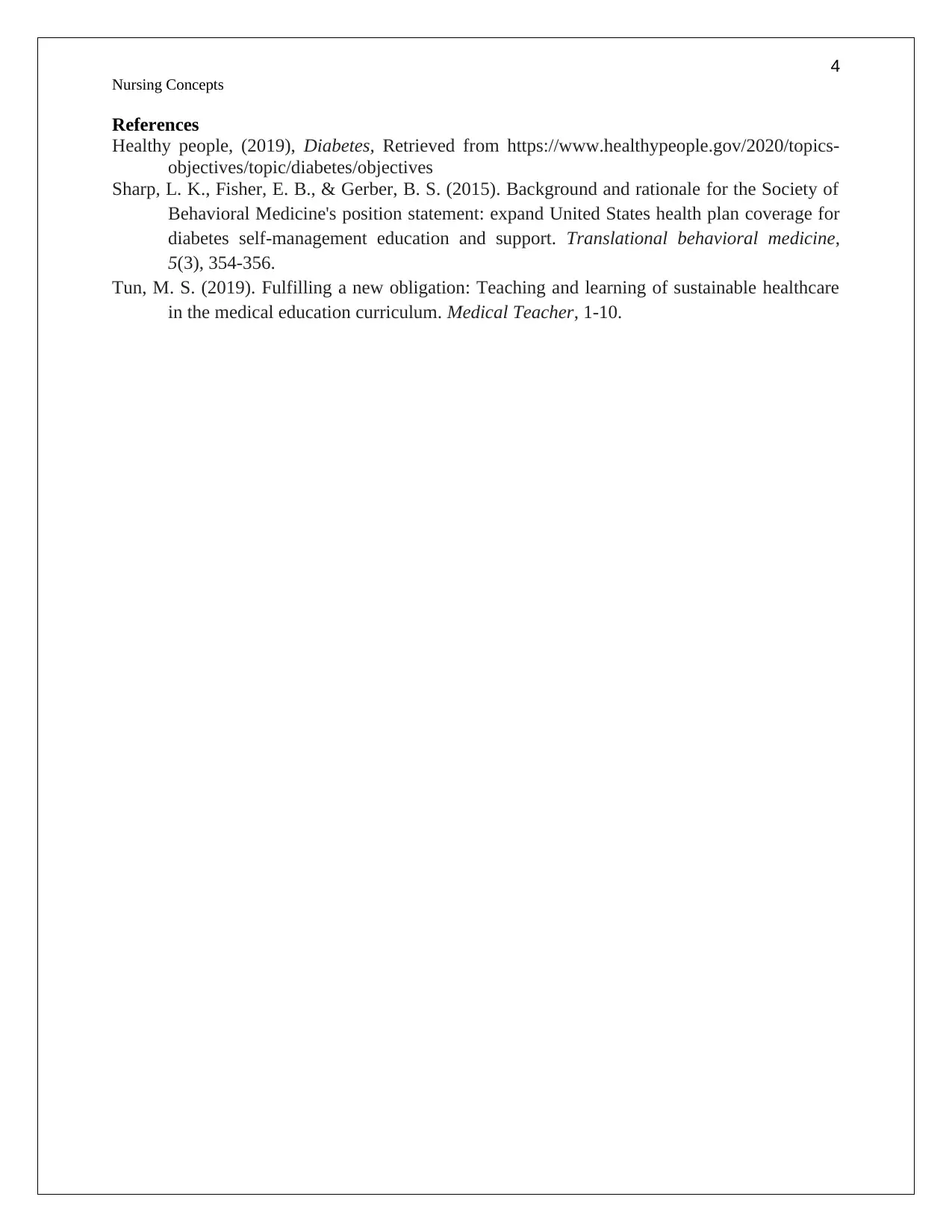Identification of Focus for Community Teaching
VerifiedAdded on 2022/11/26
|4
|1239
|199
AI Summary
This article discusses the identification of focus for community teaching on diabetic people, the epidemiological rationale for the topic, nursing diagnosis, readiness for learning, learning theory to be utilized, goals, and evaluation plans.
Contribute Materials
Your contribution can guide someone’s learning journey. Share your
documents today.

1
Nursing Concepts
Identification of Focus for Community Teaching:
The focused community chosen are diabetic people who are prone to several metabolic disorders
and form the greatest community. It is widespread and can be controlled through awareness and
lifestyle changes. Awareness through this teaching plan can be raised and people can be
persuaded to make amends in order to live a healthy life.
Epidemiological Rationale for Topic:
They have been chosen as more than 100 million adults in the US have diabetes and they form
about 9.4% of the population. The statistics have grown from 30.3 million Americans who were
diagnosed with diabetes in 2015. there are another group of about 84.1 million people who have
three diabetes conditions that can lead to type 2 state if not treated within 5 years.
Nursing Diagnosis:
Diabetes can be diagnosed through a simple blood test where the amount of glucose is measured
before and after food consumption. Diabetes is caused when the pancreas unable to make enough
insulin or the amount of glucose contains in the food items is high. diabetes is found to be of two
types: type 1 and type 2. In type 2 diabetes the pancreas has degraded with age and unable to
make enough insulin. Type 1 diabetes is an autoimmune disorder where the body attacks the
pancreas, as a result, it is not able to produce insulin (Tun, 2019).
Readiness for Learning:
Only some people are diagnosed with diabetes and take actions to amend it. it can be said that
the community does not recognize diabetes and health issues and continues to ignore the
concerns. They may have previous knowledge about it but are not willing to put effort into
learning and change their lifestyle. it can be said that they are not emotionally ready (Sharp,
Fisher & Gerber, 2015). The differences among the community prevent community programs
from providing uniform understanding and awareness.
Learning Theory to Be Utilized:
The learning which seemed suitable for the use of health promotion programmed was social
learning theory. This learning theory is suitable for adults as well as children. The theory is
stationed in the idea that all learning arises from experiences and assimilation. This kind of
learning is likely to be more durable and be able to bring about a behavioral change.
Goal:
Healthy People 2020 (HP2020) objective identifies the goal of reducing the burden over people
diagnosed with diabetes. The objective chosen is D-1, D-2, D-5. They aim to reduce the number
of people that are actually diagnosed with the disorder and reduce the number of deaths caused
by it (Healthy people, 2019). Also, the awareness program will be focused on helping people be
able to control their blood glucose level through dietary and lifestyle changes and medication.
How Does This HP2020 Objective Relate to Alma Ata’s Health for All Global Initiatives
Alma Ata’s Health for All Global Initiatives has been reinstated by the WHO. Its initiative for
diabetes is well aligned with Alma Ata’s programs. It aims to assess the impact of diabetes on
national and community health and use the information to educate people about the severances of
the disease. The awareness teaching plan would serve to educate people about the concerns
related to the disease.
Develop Behavioral Objectives (Including Domains), Content, and Strategies/Methods:
Behavioral Objective
and Domain
Content
(be specific)
Strategies/Methods
(label and describe)
Nursing Concepts
Identification of Focus for Community Teaching:
The focused community chosen are diabetic people who are prone to several metabolic disorders
and form the greatest community. It is widespread and can be controlled through awareness and
lifestyle changes. Awareness through this teaching plan can be raised and people can be
persuaded to make amends in order to live a healthy life.
Epidemiological Rationale for Topic:
They have been chosen as more than 100 million adults in the US have diabetes and they form
about 9.4% of the population. The statistics have grown from 30.3 million Americans who were
diagnosed with diabetes in 2015. there are another group of about 84.1 million people who have
three diabetes conditions that can lead to type 2 state if not treated within 5 years.
Nursing Diagnosis:
Diabetes can be diagnosed through a simple blood test where the amount of glucose is measured
before and after food consumption. Diabetes is caused when the pancreas unable to make enough
insulin or the amount of glucose contains in the food items is high. diabetes is found to be of two
types: type 1 and type 2. In type 2 diabetes the pancreas has degraded with age and unable to
make enough insulin. Type 1 diabetes is an autoimmune disorder where the body attacks the
pancreas, as a result, it is not able to produce insulin (Tun, 2019).
Readiness for Learning:
Only some people are diagnosed with diabetes and take actions to amend it. it can be said that
the community does not recognize diabetes and health issues and continues to ignore the
concerns. They may have previous knowledge about it but are not willing to put effort into
learning and change their lifestyle. it can be said that they are not emotionally ready (Sharp,
Fisher & Gerber, 2015). The differences among the community prevent community programs
from providing uniform understanding and awareness.
Learning Theory to Be Utilized:
The learning which seemed suitable for the use of health promotion programmed was social
learning theory. This learning theory is suitable for adults as well as children. The theory is
stationed in the idea that all learning arises from experiences and assimilation. This kind of
learning is likely to be more durable and be able to bring about a behavioral change.
Goal:
Healthy People 2020 (HP2020) objective identifies the goal of reducing the burden over people
diagnosed with diabetes. The objective chosen is D-1, D-2, D-5. They aim to reduce the number
of people that are actually diagnosed with the disorder and reduce the number of deaths caused
by it (Healthy people, 2019). Also, the awareness program will be focused on helping people be
able to control their blood glucose level through dietary and lifestyle changes and medication.
How Does This HP2020 Objective Relate to Alma Ata’s Health for All Global Initiatives
Alma Ata’s Health for All Global Initiatives has been reinstated by the WHO. Its initiative for
diabetes is well aligned with Alma Ata’s programs. It aims to assess the impact of diabetes on
national and community health and use the information to educate people about the severances of
the disease. The awareness teaching plan would serve to educate people about the concerns
related to the disease.
Develop Behavioral Objectives (Including Domains), Content, and Strategies/Methods:
Behavioral Objective
and Domain
Content
(be specific)
Strategies/Methods
(label and describe)
Secure Best Marks with AI Grader
Need help grading? Try our AI Grader for instant feedback on your assignments.

2
Nursing Concepts
1. People will be able to
identify food items with less
and high glucose content.
1. Food items that are
artificially sweetened,
bread, pasta and fats.
1. Posters and starch test will
be conducted in front of the
audience to convince them
about the constituents of their
food.
2. People will be able to
understand what happens in
diabetic condition and the
importance of insulin for
body metabolism.
2. The digestive and
hormonal system will be
explained to understand
body homeostasis levels.
2. A presentation and a video
will be used
Creativity:
The teaching plan would include a buddy system where partners would be made from the group
and they will be asked to review each other’s diet and lifestyle over a period of two weeks. They
would also discuss among themselves their health conditions and how they plan to improve.
Planned Evaluation of Objectives
1. Assessing the understanding and awareness level can be done through quizzes and
discussions. It is to be noted that knowledge and understanding do not mean that they will make
a behavioral change.
2. Measuring weight and glucose levels among a community will provide an insight into the
impact of the teaching plan.
Planned Evaluation of Goal:
The goal sought after is a long term one and can only be reviewed after at least a year. The
evaluation will involve a survey among the people diagnosed with diabetes and will evaluate
whether they are able to live free from the consequences of diabetes and are able to manage their
glucose levels.
Planned Evaluation of Lesson and Teacher:
Evaluation of the teacher and the lesson plan will be performed by the learners and their
presence, level of attention and willingness to learn would point to the success of the teachers.
The lessons will be evaluated through a short feedback form given to the learners which would
ask them whether they were able to learn something new or helpful or not.
Barriers:
One of the barriers can be emotional reluctance to learn and make a behavioral change. This can
be traced back to health behaviors and beliefs that are dependent on the person lifestyle,
background, culture and education. These criteria differ from people to people in the community
and cannot be accommodated in the teaching plan.
Therapeutic Communication
Therapeutic communication involves the process of interacting with a person or patient in order
to provide them emotional support and to align their health beliefs and behavior with the one that
are beneficial for their wellness and recovery. The presentation will begin with a statistic about
the life span of a person with diabetes and the other life-threatening diseases that are related to it.
Nursing Concepts
1. People will be able to
identify food items with less
and high glucose content.
1. Food items that are
artificially sweetened,
bread, pasta and fats.
1. Posters and starch test will
be conducted in front of the
audience to convince them
about the constituents of their
food.
2. People will be able to
understand what happens in
diabetic condition and the
importance of insulin for
body metabolism.
2. The digestive and
hormonal system will be
explained to understand
body homeostasis levels.
2. A presentation and a video
will be used
Creativity:
The teaching plan would include a buddy system where partners would be made from the group
and they will be asked to review each other’s diet and lifestyle over a period of two weeks. They
would also discuss among themselves their health conditions and how they plan to improve.
Planned Evaluation of Objectives
1. Assessing the understanding and awareness level can be done through quizzes and
discussions. It is to be noted that knowledge and understanding do not mean that they will make
a behavioral change.
2. Measuring weight and glucose levels among a community will provide an insight into the
impact of the teaching plan.
Planned Evaluation of Goal:
The goal sought after is a long term one and can only be reviewed after at least a year. The
evaluation will involve a survey among the people diagnosed with diabetes and will evaluate
whether they are able to live free from the consequences of diabetes and are able to manage their
glucose levels.
Planned Evaluation of Lesson and Teacher:
Evaluation of the teacher and the lesson plan will be performed by the learners and their
presence, level of attention and willingness to learn would point to the success of the teachers.
The lessons will be evaluated through a short feedback form given to the learners which would
ask them whether they were able to learn something new or helpful or not.
Barriers:
One of the barriers can be emotional reluctance to learn and make a behavioral change. This can
be traced back to health behaviors and beliefs that are dependent on the person lifestyle,
background, culture and education. These criteria differ from people to people in the community
and cannot be accommodated in the teaching plan.
Therapeutic Communication
Therapeutic communication involves the process of interacting with a person or patient in order
to provide them emotional support and to align their health beliefs and behavior with the one that
are beneficial for their wellness and recovery. The presentation will begin with a statistic about
the life span of a person with diabetes and the other life-threatening diseases that are related to it.

3
Nursing Concepts
A presentation and video of case studies will be showcased to provide a humane touch to the
teaching plan and to ensure that the people are attentive.
Nursing Concepts
A presentation and video of case studies will be showcased to provide a humane touch to the
teaching plan and to ensure that the people are attentive.

4
Nursing Concepts
References
Healthy people, (2019), Diabetes, Retrieved from https://www.healthypeople.gov/2020/topics-
objectives/topic/diabetes/objectives
Sharp, L. K., Fisher, E. B., & Gerber, B. S. (2015). Background and rationale for the Society of
Behavioral Medicine's position statement: expand United States health plan coverage for
diabetes self-management education and support. Translational behavioral medicine,
5(3), 354-356.
Tun, M. S. (2019). Fulfilling a new obligation: Teaching and learning of sustainable healthcare
in the medical education curriculum. Medical Teacher, 1-10.
Nursing Concepts
References
Healthy people, (2019), Diabetes, Retrieved from https://www.healthypeople.gov/2020/topics-
objectives/topic/diabetes/objectives
Sharp, L. K., Fisher, E. B., & Gerber, B. S. (2015). Background and rationale for the Society of
Behavioral Medicine's position statement: expand United States health plan coverage for
diabetes self-management education and support. Translational behavioral medicine,
5(3), 354-356.
Tun, M. S. (2019). Fulfilling a new obligation: Teaching and learning of sustainable healthcare
in the medical education curriculum. Medical Teacher, 1-10.
1 out of 4
Related Documents
Your All-in-One AI-Powered Toolkit for Academic Success.
+13062052269
info@desklib.com
Available 24*7 on WhatsApp / Email
![[object Object]](/_next/static/media/star-bottom.7253800d.svg)
Unlock your academic potential
© 2024 | Zucol Services PVT LTD | All rights reserved.





